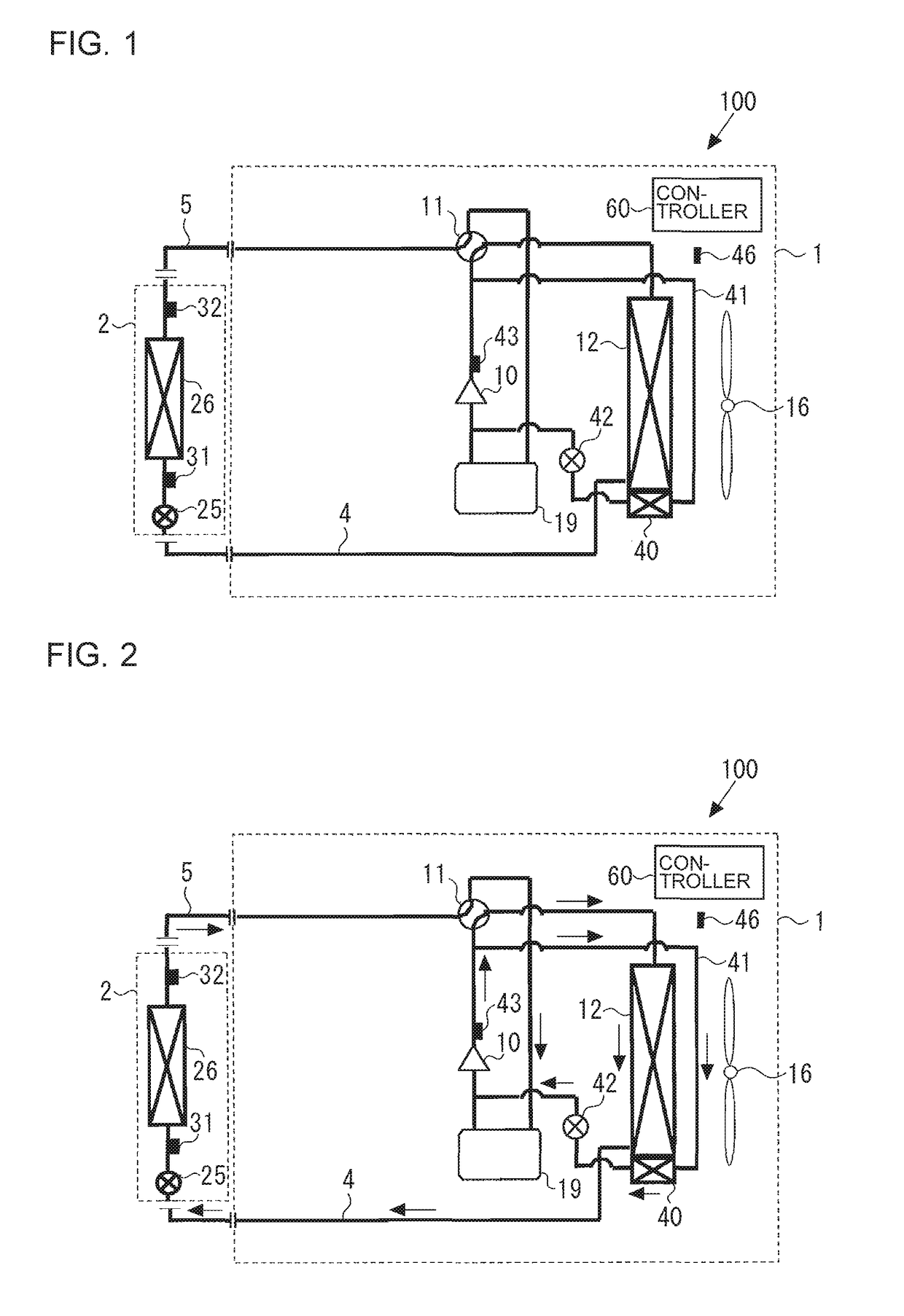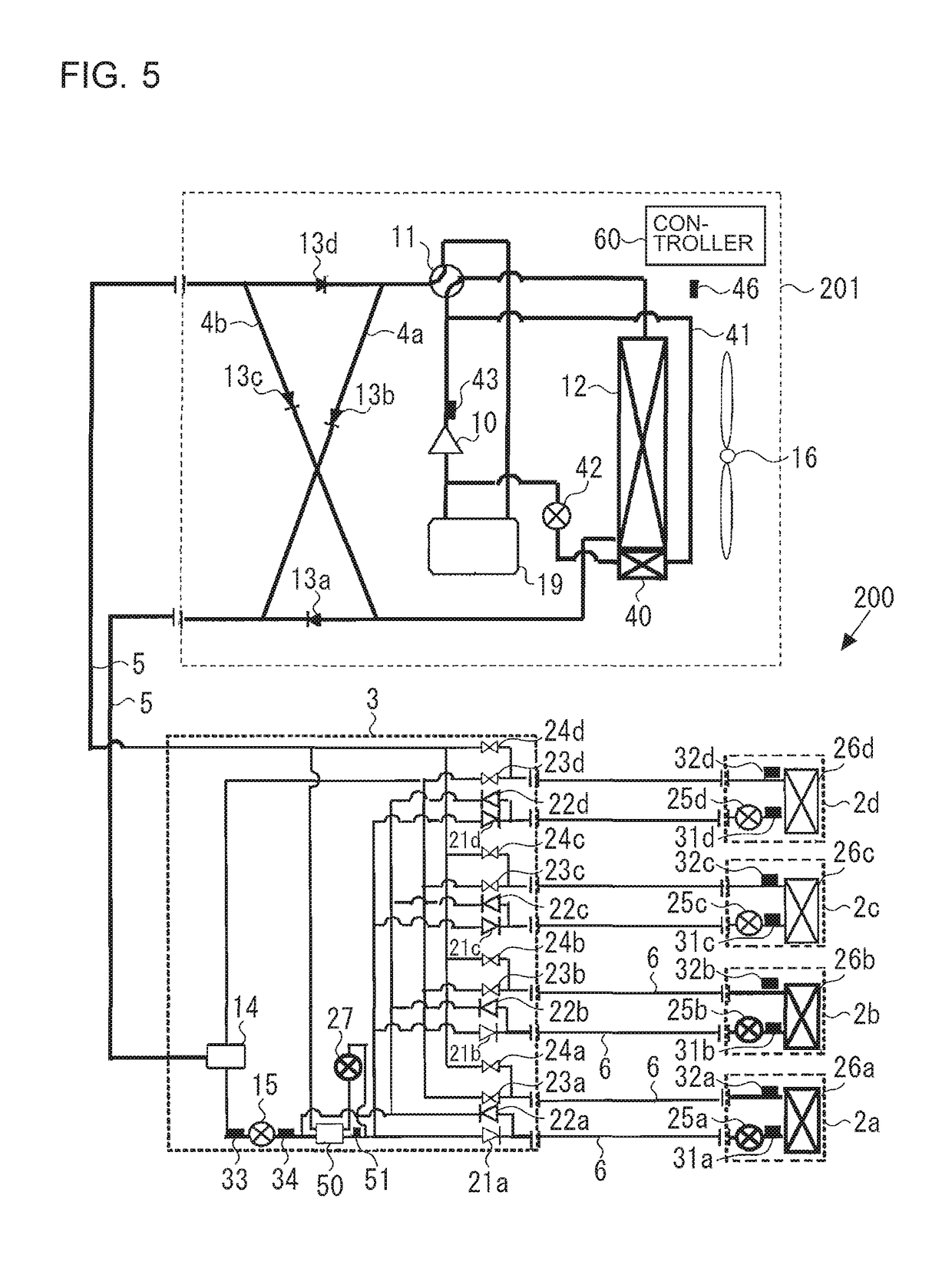Heat pump with an auxiliary heat exchanger for compressor discharge temperature control
a heat pump and compressor technology, applied in the field of airconditioning equipment, can solve the problems of insufficient cooling capacity or heating capacity, insufficient cooling capacity, damage to the compressor, etc., and achieve the effect of limiting the rise in the temperature of refrigerant discharged and improving the reliability of the system inexpensively
- Summary
- Abstract
- Description
- Claims
- Application Information
AI Technical Summary
Benefits of technology
Problems solved by technology
Method used
Image
Examples
embodiment 1
[0024]Hereinafter, an air-conditioning apparatus according to Embodiment 1 of the present invention will be described with reference to the drawings. FIG. 1 is a schematic circuit configuration diagram illustrating an exemplary circuit configuration of the air-conditioning apparatus according to Embodiment 1. An air-conditioning apparatus 100 illustrated in FIG. 1 includes an outdoor unit 1 and an indoor unit 2 that are connected by a main pipe 5. Although a single indoor unit 2 is connected to the outdoor unit 1 via the main pipe 5 in FIG. 1, this is not intended to limit the number of indoor units 2 to one. Alternatively, a plurality of indoor units 2 may be connected.
[Outdoor Unit 1]
[0025]In the outdoor unit 1, a compressor 10, a refrigerant flow switching device 11, a heat source-side heat exchanger 12, an accumulator 19, an auxiliary heat exchanger 40, a flow regulating unit 42, and a bypass pipe 41 are connected by a refrigerant pipe 4 (refrigerant pipes 4), and are mounted to...
embodiment 2
[0083]FIG. 5 is a refrigerant circuit diagram illustrating an exemplary circuit configuration of an air-conditioning apparatus according to Embodiment 2 of the present invention. An air-conditioning apparatus 200 will be described below with reference to FIG. 5. In FIG. 5, parts configured in the same manner as those in the air-conditioning apparatus 100 illustrated in FIG. 1 will be denoted by the same reference signs to omit a description of these parts.
[0084]The air-conditioning apparatus 200 illustrated in FIG. 5 has a single outdoor unit 201, which is a heat source unit, a plurality of indoor units 2a to 2d, and a relay device 3 with an opening and closing device provided between the outdoor unit 201 and each of the indoor units 2a to 2d. The outdoor unit 201 and the relay device 3 are connected by the main pipe 5 through which refrigerant flows, and the relay device 3 and the indoor units 2a to 2d are connected by a branch pipe 6 through which refrigerant flows. The cooling en...
embodiment 3
[0134]FIG. 10 is a refrigerant circuit diagram illustrating the flow of refrigerant in heating only operation mode of an air-conditioning apparatus according to Embodiment 3. The following description of Embodiment 3 will mainly focus on differences from Embodiment 2, and parts that are the same as those in Embodiment 2 will be denoted by the same reference signs. An air-conditioning apparatus 300 illustrated in FIG. 10 differs from the air-conditioning apparatus 200 illustrated in FIGS. 5 to 9 in the configuration of an outdoor unit 301.
[0135]In the outdoor unit 301 of the air-conditioning apparatus 300, one end of the bypass pipe 41 is connected to the part of the refrigerant pipe 4 between the first backflow prevention device 13a and the main pipe 5.
[0136]When a rise in the temperature of refrigerant discharged from the compressor 10 is to be limited in cooling only operation mode and cooling main operation mode, a part of the high-pressure liquid refrigerant exiting the heat sou...
PUM
 Login to View More
Login to View More Abstract
Description
Claims
Application Information
 Login to View More
Login to View More - R&D
- Intellectual Property
- Life Sciences
- Materials
- Tech Scout
- Unparalleled Data Quality
- Higher Quality Content
- 60% Fewer Hallucinations
Browse by: Latest US Patents, China's latest patents, Technical Efficacy Thesaurus, Application Domain, Technology Topic, Popular Technical Reports.
© 2025 PatSnap. All rights reserved.Legal|Privacy policy|Modern Slavery Act Transparency Statement|Sitemap|About US| Contact US: help@patsnap.com



